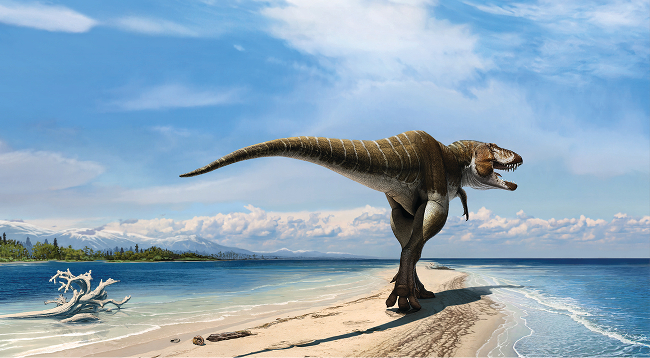This article is more than 1 year old
Blood king of the tyrannosaurus, grandad of T-Rex
New and extra nasty overlord flesh-eater discovered
A new kind of vicious tyrannosaur that pre-dates Tyrannosaurus rex has been unearthed in southern Utah and christened the "King of Gore".

The Tyrannosauridae family already contains massive creatures whose names translate as "frightful" and "fierce" kings as well as "monstrous murderer". Now the newest royal addition to the dinosaur family tree has been named Lythronax argestes - literally the king of gore (or sinister blood, if you will) from the southwest.
Paleoboffins previously thought that this branch of the tree, which features wide-skulled tyrannosauridae, only appeared 70 million years ago, but the appearance of L argestes proves that the ancient animals evolved at least 10 million years earlier.
"The width of the back of the skull of Lythronax allowed it to see with an overlapping field of view — giving it binocular vision — very useful for a predator and a condition we associate with T rex," said Dr Mark Loewen of the Natural History Museum of Utah, lead author on the study.
Loewen worked with boffins from the universities of Utah and Alberta, along with others from the Denver Museum of Nature and Science, on the skeleton, which was discovered by an employee of the Bureau of Land Management in Grand Staircase-Escalante National Monument in Utah.
The researchers reckon that the species from the Lythronax genus lived on Laramidia, along the western shores of the seaway that separated North America, where a large number of unique dinosaur species lived and iconic ancient lizards like horned and duck-billed dinosaurs evolved. Tyrannosaurid dinosaurs likely evolved in isolation on this island continent, with those in the south like Lythronax and T rex more closely related than their long-snouted brethren on the northern side of the landmass.
"Lythronax and other tyrannosaurids diversified between 95 and 80 million years ago, during a time when North America's interior sea was at its widest extent," explained Dr Randall Irmis of the Utah museum and university.
"The incursion of the seaway onto large parts of low-lying Laramidia would have separated small areas of land from each other, allowing different species of dinosaurs to evolve in isolation on different parts of the landmass."
As the sea gradually receded, dinosaur differences could have been reinforced by climate variations and varying food sources, helping to explain why the iconic Late Cretaceous lizards of Laramidia are so different from those of the same age on other continents.
Over the last 14 years, palaeontologists have discovered more than a dozen new species of dinosaur in the same monument, including horned, dome-headed, duck-billed and carnivorous varieties, along with fossilised plants, insects, mammals and other animals.
"Lythronax is a wonderful example of just how much more we have to learn about with world of dinosaurs. Many more exciting fossils await discovery in Grand Staircase-Escalante National Monument," said Dr Philip Currie of the University of Alberta.
The full study, "Tyrant Dinosaur Evolution Tracks the Rise and Fall of Late Cretaceous Oceans", was published in the open-access PLOS One journal at the same time as an exhibit opened at the Natural History Museum of Utah. ®
